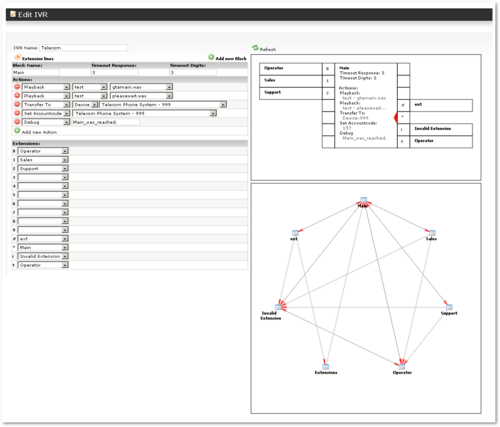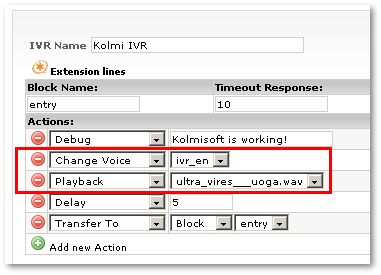Difference between revisions of "IVR system"
m (→Actions) |
|||
| Line 108: | Line 108: | ||
* Debug – text message to Asterisk CLI which helps debugging. | * Debug – text message to Asterisk CLI which helps debugging. | ||
* Set Accountcode - sets ownership for the call to some other user. | * Set Accountcode - sets ownership for the call to some other user. | ||
* Set CallerID (Number) - documentation comming soon for this one. | |||
<br><br> | |||
== Timeouts == | == Timeouts == | ||
Revision as of 10:52, 14 June 2011
This system makes it possible to configure advanced IVR (Interactive Voice Response) systems.
Definitions
- Voices – a set of audio files, such as male/female recordings, that together form a "voice" for the same IVR.
- Time Periods – a start date/time and end date/time that describe a time period.
- IVR – a set of IVR blocks.
- Blocks – a part of IVR in which the caller can take some action (press a button-extension, listen to a recording, etc). Basically block in IVR is "set of rules".
- Extensions – possible button presses (0-9, *, # and some other special cases).
- Actions – what action the system should take when a new Block is reached.
Setup logic
- Create Voice
- Record and upload the necessary sound files to Voice.
- Create Time Period(s).
- Create IVR.
- Create and configure Block(s).
- Create the IVR Dial Plan.
- Assign this IVR Dial Plan to a DID.
- Call this DID to test it.
IVR Voices
SETTINGS - Setup - IVR - Voices
Here it is possible to create several Voices. A Voice consists of a set of sound files. Usually all the sound files in one Voice are recorded by one person to keep the sound consistent.
Multiple operations can be performed with Voices:
- View a detailed list of the system Voices.
- Add a new sound Voice.
- View the sounds that have files in different Voices.
- Upload new sound files for Voices.
- Delete Voices and voice files from the system.
You cannot remove sounds that are currently used.
Time Periods
SETTINGS - Setup - IVR - Time Periods
Here time periods can be set. Time period defines the exact time period IVR will be active. There is a limit of three periods in Dial Plan. There is a fourth period, but it only consists of all the remaining time that is not covered by the previous three periods.
IVR Structure
- IVR – consists of a set of IVR blocks.
- Blocks – part of IVR in which a caller can take some action (press a button-extension, listen to a recording, etc).
- Extensions – possible button presses (0-9, *, # and some other special cases).
- Actions – what action the system should take when an extension is activated.
The main part of IVR is Blocks. The whole of IVR is a set of Blocks. A Block can be considered as a part of IVR logic where a caller can take some action.
Extension is what the user does – presses a button (0-9, *, #), waits (Timeout), or presses any non-described extension – which can be described as an Invalid Extension. We explain this in detail later.
Actions are actions which will be activated when the caller comes to a Block.
Example
For example, here is a simple IVR:
- A caller calls a DID and IVR answers with a recording: "Thank you for calling SOME COMPANY. For sales press 1, for management press 2, to speak to a consultant please hold or press 3."
Here we have only one block: the user listens to the recording and can take some Action -> press some button (Extension) or wait (Wait is also Extension but is special - it is called Timeout).
If the user presses something different than 1, 2 or 3, the message will be played again. This is called an Invalid Extension, or (i) for short.
To summarize, we have the following situation:
- 1 Block.
- Extensions: 1, 2, 3, t (timeout), i (invalid).
- Actions: call to sales, call to management, call to a consultant, play recording again.
This example is to illustrate the main IVR building parts. We will show how they operate together to build a working IVR.
Extensions
Extensions are button presses on the dialpad: 0, 1, 2, 3, 4, 5, 6, 7, 8, 9, * and # and two special extensions:
- t - means "timeout", when no extension is pressed in a determined time period.
- i - means "invalid". This extension becomes active when a caller presses some extensions that are not described in the IVR block configuration.
The 'i' (invalid) extension in the previous example could be triggered when buttons 4, 5, 6, 7, 8, 9, 0, *, # are pressed, because only 1, 2 and 3 are described.
Actions
An Action is some (yes...) action which is executed when a new Block is reached.
Possible Actions:
- Playback – plays a sound file.
- Delay – delays execution by some seconds.
- Change Voice – changes IVR Voice.
- Hangup – finishes the call.
- Transfer to – transfers the call to:
- Another IVR.
- DID.
- Device.
- Block.
- Debug – text message to Asterisk CLI which helps debugging.
- Set Accountcode - sets ownership for the call to some other user.
- Set CallerID (Number) - documentation comming soon for this one.
Timeouts
Timeout digits
The maximum amount of time permitted between digits when the user is typing in an extension. When this timeout expires after the user has started to type in an extension, the extension will be considered complete, and will be interpreted. Note that if an extension typed in is valid, it will not have to timeout to be tested, so typically at the expiry of this timeout, the extension will be considered invalid (and thus control would be passed to the 'i' extension, or if none exists the call would be terminated). The default timeout (in MOR IVR) is 3 seconds.
Timeout Response
The maximum amount of time permitted after falling through a series of priorities for a channel in which the user may begin typing an extension. If the user does not begin typing an extension in this amount of time, control will pass to the 't' extension if one exists, or if none exists, the call would be terminated. Once the user begins to type an extension, Asterisk will wait for digit timeout to be reached, and response timeout has no effect. The default timeout (in MOR IVR) is 10 seconds.
Deleting IVR
- If an IVR is not assigned to any Dial Plan, you can delete the IVR by clicking the
 icon near an IVR in the IVR menu.
icon near an IVR in the IVR menu. - If the IVR is assigned to a Dial Plan, you need to unassign the IVR from the Dial Plan to be able to delete it.
Setup Hints/Tips
- If you want to play a sound file, make sure you have set the correct Voice. By default, Voice = 'en'. If you have uploaded a sound file for a different Voice, select it before playing your Sound File:
Limitations
- Currently it is not possible to record calls for a device which is accessed from IVR. For example, if calls go like this: IVR -> Device, and device has option to record calls for this device, these calls will not be recorded.


